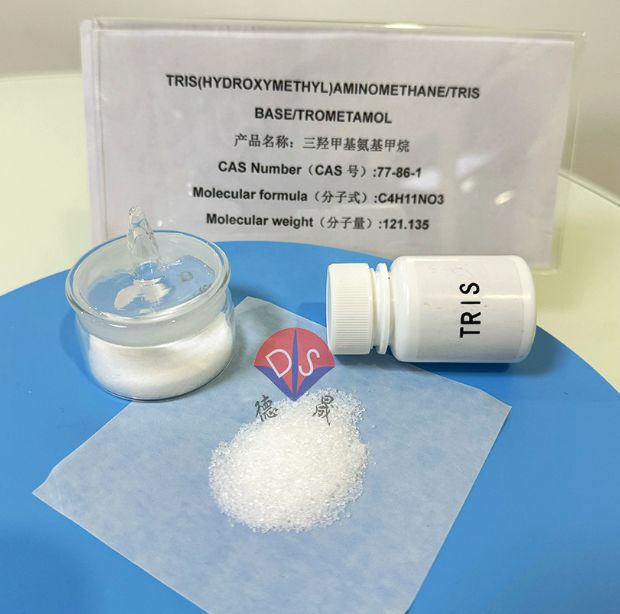Reasons for the difference between the pH buffer solution of trihydroxymethyl aminomethane and the actual pH measurement
Release time:
2025-08-17
Tris buffer is widely used in chemical and biological experiments due to its excellent buffering performance. However, in the actual operation process, researchers sometimes find that the measured pH value of the prepared Tris pH buffer solution differs from the theoretical expected value, which involves multiple factors.

Tris base powder
Temperature factor
1. The influence of temperature on Tris buffering principle: The buffering capacity of Tris buffer is based on the protonation and deprotonation equilibrium of amino and hydroxyl groups in its molecular structure under different acid-base environments. Changes in temperature can significantly disrupt this equilibrium process. As the temperature increases, the thermal motion of molecules intensifies, and the interaction between Tris molecules and water molecules increases, resulting in a change in their dissociation constant (pKa). At higher temperatures, Tris buffer is more likely to give protons, increasing the acidity of the solution and reducing the pH value accordingly; On the contrary, when the temperature decreases, the alkalinity of the solution relatively increases and the pH value increases.
2. Temperature deviation in experimental operation: When preparing Tris buffer in the laboratory, if the temperature is not strictly controlled, it is easy to cause deviation in the measured pH value. For example, using an uncalibrated constant temperature water bath, the actual water temperature may differ significantly from the set temperature. In addition, if the buffer solution is placed for a long time near a heat source or direct sunlight, temperature fluctuations can also cause the pH value to become unstable, resulting in differences from the theoretical calculation value at the initial preparation.
Solution concentration factor
1. The effect of concentration on buffering capacity and pH: The concentration of Tris buffer directly affects its buffering capacity and pH accuracy. When the concentration of Tris deviates from the ideal value, it can cause a series of problems. The concentration is too low and the buffer capacity is insufficient. When a small amount of acid or alkali is added, the pH value of the solution will fluctuate significantly, making it difficult to maintain a stable acid-base environment. For example, in some enzymatic reaction experiments that require high pH stability, if the Tris concentration is not sufficient, enzyme activity may be inhibited due to pH changes, affecting the experimental results. On the other hand, a high concentration is not ideal. A high solute concentration can alter the ionic strength of the solution, thereby affecting the dissociation equilibrium of Tris molecules, causing the measured pH value to deviate from the theoretical value, and may also interfere with the activity of other biomolecules in subsequent experiments.
2. Weighing and dilution errors: In the actual preparation process, minor errors in the weighing process are common causes of inaccurate concentration. Insufficient accuracy of the balance used, high humidity during weighing, and incorrect readings by the operator may all cause deviations in the mass of Tris being weighed. The dilution process also carries risks. If the scale of the volumetric flask is inaccurate and the line of sight is not level with the scale line during volume determination, it can cause inaccurate solution volume, resulting in the actual concentration of Tris buffer not matching the expected value, which in turn affects the pH value.
Impurity factors
1. Raw material purity issue: If the purchased Tris raw material contains impurities, these impurities may participate in acid-base reactions, thereby interfering with the buffer system. For example, if there are a small amount of acidic or alkaline substances in the impurities, additional hydrogen ions or hydroxide ions will be introduced when preparing the buffer solution, changing the initial acid-base balance of the solution and causing the measured pH value to deviate from the theoretical calculation value. Some low-quality Tris products may contain unreacted raw materials, synthetic by-products, or impurities such as heavy metal ions, which can have adverse effects on the performance of the buffer solution.
2. Impurities introduced by solvents and containers: The solvents used to prepare Tris buffer are usually distilled water or deionized water. If the water quality is impure and contains trace amounts of metal ions, chloride ions, or organic compounds, it can also affect the pH value of the buffer.

Product packaging
Measurement error factors
If the pH meter is not calibrated regularly, parameters such as electrode slope and zero drift will deviate, and the measured pH value will inevitably be inaccurate. Before using a pH meter, a standard buffer solution should be used for calibration, and the pH range of the buffer used for calibration should cover the approximate pH value of the Tris buffer to be tested. In addition, the operational details during the measurement process cannot be ignored, such as the electrode not being fully immersed in the solution, the solution not being stirred evenly during measurement, and bubbles adhering to the electrode surface, all of which can lead to measurement errors and result in pH values that do not match the actual values.
As a manufacturer of trihydroxymethylaminomethane, Hubei Xindesheng's biological buffer range meets the requirements of most experiments, and its buffering performance is stable, which is highly trusted by customers. If you are interested, please feel free to click on the website for consultation at any time!
Previous page
Previous page
News
Contact details
Contact number
Address: C8, Guanggu United Science and Technology City, Ezhou City, Hubei Province
Fax:0711-3704 589
Follow us



